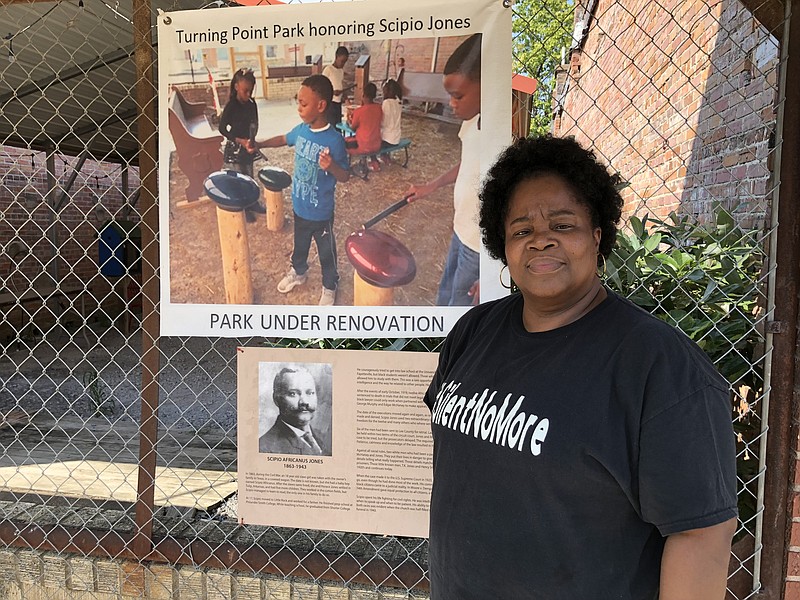"Silent No More," a multimedia exhibit about the 1919 Elaine Massacre, will open in Elaine on Friday, the 103rd anniversary of the racial violence that took place in Phillips County.
The exhibit is presented by Descendants of the Elaine Massacre of 1919 and will be shown at the former Elaine High School through Saturday.
"Visitors will be able to see what sharecropper's agreements with plantation owners looked like, and view copies of letters written by a soldier who was on the ground in Elaine during the Massacre," according to a news release. The exhibit will include a historical timeline of the massacre, art, digital stories and the names of known victims and survivors.
It will also feature information on Little Rock attorney Scipio A. Jones and his work to have the death sentences of 12 Black men, known as the Elaine Twelve, overturned after they were convicted in the aftermath of the violence. The work of journalist Ida B. Wells-Barnett, who wrote firsthand accounts of the massacre, will also be highlighted.
Lisa Hicks-Gilbert is the founder of the Descendants of the Elaine Massacre of 1919 and is organizing the exhibit.
"It's storytelling, and more of an educational exhibit," Hicks-Gilbert, 54, says.
Though she grew up near Elaine, graduated from Elaine High School and is a descendant of massacre victims, Hicks-Gilbert says she never heard of the event until 2007. She was taking a history class at the University of Arkansas-Pulaski Technical College in North Little Rock and came across Grif Stockley's 2001 book "Blood in Their Eyes: The Elaine Race Massacres of 1919."
"I literally thought it was something someone had made up. I couldn't believe that this had happened and I had grown up there and didn't know about it."
A couple of weeks later she asked her grandmother, Bernice Knox-Hicks, who died in 2019, about it.
"She went real still and she turned and I could tell it startled her," she says. "I asked her, 'did this happen for real,' because I think I wanted to believe it did not happen. She said 'Yeah, baby, that happened.'"
■ ■ ■
On the evening of Sept. 30, 1919, a shootout occurred during a meeting of Black sharecroppers and the Progressive Farmers and Household Union of America in a church at Hoop Spur, three miles north of Elaine. The meeting was part of efforts to help Black workers receive better payments for their crops from white plantation owners.
A white security officer was killed and a Phillips County deputy sheriff was wounded. What followed over the next several days was what the online Encyclopedia of Arkansas calls the "deadliest racial confrontation in Arkansas history and possibly the bloodiest racial conflict in the history of the United States." It is believed that hundreds of Black people were killed by white mobs.
Officials in nearby Helena, the county seat, fearing an insurrection by Black people, requested Gov. Charles Hillman Brough send troops to Elaine. Brough sent more than 500 soldiers from Camp Pike in North Little Rock and accompanied them to Phillips County. Hundreds of Black men and some women were jailed in Helena, and 122 were charged with crimes ranging from murder to nightriding.
The Elaine Twelve — Frank Moore, Frank Hicks, Ed Hicks, Joe Knox, Paul Hall, Ed Coleman, Alfred Banks, Ed Ware, William Wordlaw, Albert Giles, Joe Fox and John Martin — were sentenced to death after hastily conducted trials. Wells-Barnett, who secretly interviewed members of the Elaine Twelve in jail, first wrote a detailed account of the events in her 1920 pamphlet "Arkansas Race Riot."
For decades, information about the massacre was presented from the white perspective as a revolt by Black people out to kill whites. In recent years, historians have turned to Wells-Barnett's work along with that of Stockley and Robert Whitaker's 2008 book, "On the Laps of Gods, The Red Summer of 1919 and the Struggle for Justice That Remade a Nation."
■ ■ ■
Exhibit visitors won't have any trouble remembering the year the massacre took place. Memphis contractor Casey Perry, who grew up in Helena, used two-by-fours and luan, a type of thin plywood, to create an eight-foot tall 1919 in yellow that will be part of the display.
"The history of Elaine and 1919 is just so interesting to me," he says. "I wanted to do something that was memorable and that would symbolize why we were there. And I wanted everybody to see it down the whole street."
He's also building replicas of pews from the Hoop Spur church, which was burned down.
"I'd like to make people feel what the people of that era felt and see what they must have seen," Perry says.
Hicks-Gilbert, who is the volunteer program manager for the nonprofit Lee Street Community Center in Elaine, says she hopes the exhibit will find a permanent home. In the meantime, this weekend's event will feature massacre descendants and their stories as a way to help people understand and learn about what happened.
"The descendants needed to reclaim the narrative and make sure that the work about us included us," Hicks-Gilbert says. "The exhibit will be a historical timeline, and will include our voices as narrators. My greatest hope for this is for people to hear, finally hear, descendants of the victims of the Elaine Massacre speak and tell our stories."
